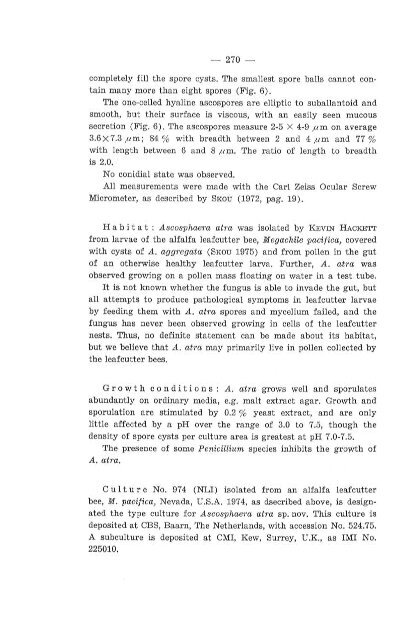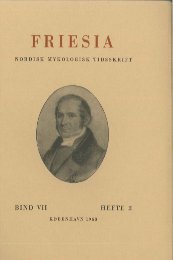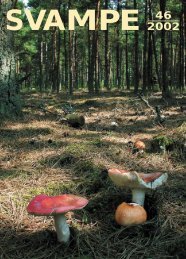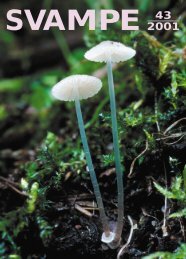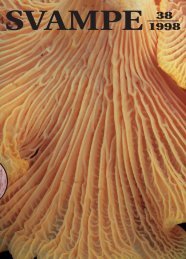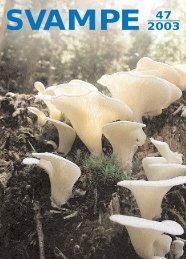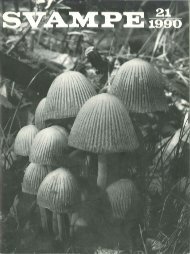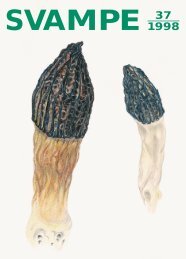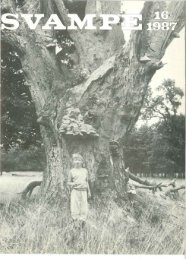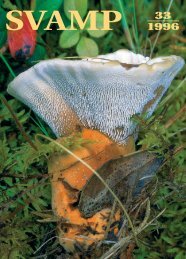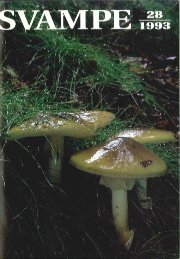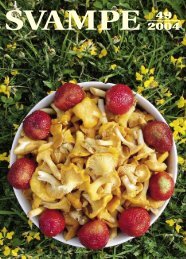Friesia XI, 5
Friesia XI, 5
Friesia XI, 5
You also want an ePaper? Increase the reach of your titles
YUMPU automatically turns print PDFs into web optimized ePapers that Google loves.
- 270-<br />
completely fill the spore cysts. The smallest spore balls eannot contain<br />
many more than eight spores (Fig. 6).<br />
The one-celled hyaline ascospores are elliptic to suballantoid and<br />
smooth, but their surface is viscous, with an easily seen mucous<br />
secretion (Fig. 6). The ascospores measure 2-5 X 4-9 ,um on average<br />
3.6x7.3,um; 84 % with breadth between 2 and 4,um and 77 %<br />
with length between 6 and 8,um. The ratio of length to breadth<br />
is 2.0.<br />
No conidial state was observed.<br />
All measurements were made with the Carl Zeiss Ocular Screw<br />
Micrometer, as deseribed by SKOU (1972, pag. 19).<br />
H a b i t a t : Ascosphaera atra was isolated by KEVIN HACKETT<br />
from larvae of the alfalfa leafcutter bee, Megachile pacijica, covered<br />
with cysts of A. aggregata (SKOU 1975) and from pollen in the gut<br />
of an otherwise healthy leafcutter larva. Further, A. atra was<br />
observed growing on a pollen mass floating on water in a test tube.<br />
n is not known whether the fungus is able to invade the gut, but<br />
all attempts to produce pathological symptoms in leafcutter larvae<br />
by feeding them with A. atra spores and mycelium failed, and the<br />
fungus has never been observed growing in cells of the leafcutter<br />
nests. Thus, no definite statement can be made about its habitat,<br />
but we believe that A. atra may primarily live in pollen collected by<br />
the leafcutter bees.<br />
G r o w t h c o n d i t i o n s : A. atra grows well and sporulates<br />
abundantly on ordinary media, e.g. malt extract agar. Growth and<br />
sporulation are stimulated by 0.2 % yeast extract, and are only<br />
little affected by a pH over the range of 3.0 to 7.5, though the<br />
density of spore cysts per culture area is greatest at pH 7.0-7.5.<br />
The presence of some Penicillium species inhibits the growth of<br />
A. atra.<br />
C u l t u r e No. 974 (NLI) isolated from an alfalfa leafcutter<br />
bee, M. paciiica, Nevada, U.S.A. 1974, as dsecribed above, is designated<br />
the type culture for Ascosphaera atra sp. nov. This culture is<br />
deposited at CBS, Baarn, The Netherlands, with accession No. 524.75.<br />
A subculture is deposited at CMI, Kew, Surrey, U.K., as IMI No.<br />
225010.


